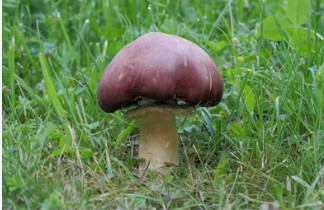Edible mushrooms are a healthy food, rich in protein, vitamins, amino acids, carbohydrates, fiber, and minerals, and low in fat, and other nutritional values, which meet modern healthcare needs. At present, there is a large market demand for both edible mushrooms and health products made by combining edible mushrooms with everyday foods. The large bulbous mushroom is an edible mushroom recommended by the FAO for developing countries and traded internationally. Pharmacological activities have been reported, including anti-tumor, hypoglycaemic, antibacterial, and antioxidant properties.
Lifeasible offers tissue culture services for Stropharia rugosoannulata. Our tissue culture service can help you select high-quality mushroom strains for your research, as they have significant potential for use in the food and pharmaceutical industries.
Identifying Characteristics of Stropharia rugosoannulata
Cap: initially convex, later flattened, up to 20 cm diameter, fleshy, often with a white peridium. The epidermis is easily separated, typically in a purplish red or purplish brown form, with a yellowish native form that is completely uniform. The lamellae attached to the stem are rounded, with finely toothed margins, initially yellow, then grey, tending to purple when ripe. Stalk: Strong, less strong in yellow, cylindrical. With a conspicuous white rhizome. With a broad, uniform ring, membranous, with a conspicuous stripe on the upper surface, yellow, and heavily speckled with spores when ripe. Flesh: white, colorless, with a slight smell of raw potatoes or turnips; sweet and slightly astringent taste.

Our Services
- Lifeasible offers tissue culture services for Stropharia rugosoannulata. We can isolate Stropharia rugosoannulata, but also clearly observe the growth of Stropharia rugosoannulata mycelium, spores and colonies. This provides reliable technical support for the isolation, purification, identification and functional development of Stropharia rugosoannulata.
- Stropharia rugosoannulata was cultured in the medium at 10-21℃ and a humidity of 85%. The grown mycelium will be used for further propagation and professional strain production and refined by natural selection into high-yielding strains.
- The cultures we offer are completely free of other strains or contaminated organisms. Our pure cultures are custom made and our scientists will perform experiments using plant-based solid media in clean experiments upon your order.
- Our service workflow focuses on but is not limited to, the following steps:
 Strain processing Strain isolation Mycelial growth Strain purification Strain identification
Strain processing Strain isolation Mycelial growth Strain purification Strain identification
What Are the Health Benefits of Stropharia rugosoannulata?
The mushroom has high nutritional and medicinal value:
Nutritional value
- Agaricus blazei is high in carbohydrates, protein, fiber, and minerals and low in fat and sodium/potassium. This makes it suitable for low-fat, healthy diets.
Medicinal value
- Antioxidant properties
- Maintains bone health
- Antifungal properties
- Antibacterial properties
- Treats brain disorders
- Relieves from cancer
- Reduces cholesterol levels
- Treats diabetes
Contact Us
If you are interested in our services, please contact us for a more detailed description of our services.
References
- Wei L, et al. Assessment of the quality characteristics of Stropharia rugosoannulata subjected to five different drying methods. Journal of Food Processing and Preservation, 2023, 2518620-12.
- Zhang W, et al. Isolation and characterization of a novel lectin from the edible mushroom Stropharia rugosoannulata. Molecules. 2014; 19 (12): 19880-91.
For research or industrial raw materials, not for personal medical use!



 Strain processing Strain isolation Mycelial growth Strain purification Strain identification
Strain processing Strain isolation Mycelial growth Strain purification Strain identification 